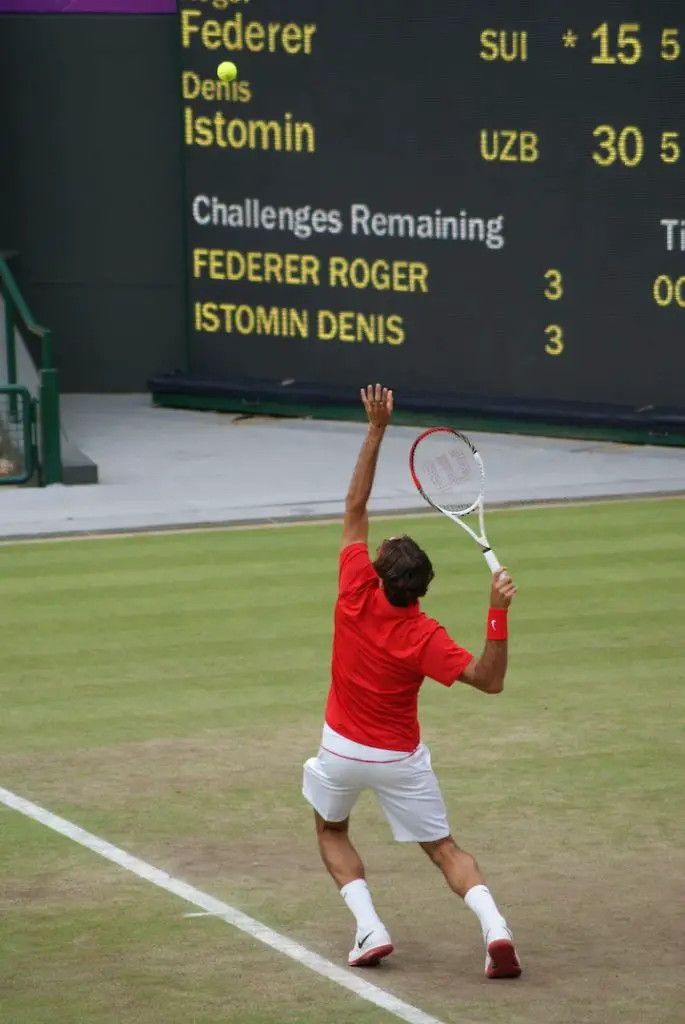Your Guide
 Gavin Davison
Gavin Davison
A quick introduction to tennis match lengths
Tennis is an interesting game when it comes to the scoring system, how to win points and match lengths.
The latter is what I will be addressing here, and if you are an avid tennis fan, I have a feeling that you will find this piece QUITE INSIGHTFUL.

Throughout the information below, I will explain the different formats that tennis uses, for both males and females, and I’ve also thrown in some bonus records that I found quite fascinating.
So, without further ado, let’s get the ball rolling with the different formats that impact the length of a match.
The different formats played
Did you know that tennis isn’t always played in the same format for men, women, and juniors?
It’s also not the same format when you look at the differing levels of the game, ranging from ITF events all the way to the Grand Slam level.
In fact, there are three main formats that tennis follows at these different levels, and I’ve detailed them right here.
Best of Three
This is the most common format of tennis, and as stated, it is the ‘best of three’ format.
Since the set format of tennis NEVER ACTUALLY CHANGES, this format means that players compete over the course of three tie-break sets (with the third only played if the first two sets are split between players).
Should a set go to 5-5, it is a win-by-two format, with a tie-break at 6-6 to determine the winner of a set.
This format is played in almost all ITF tournaments, and it is even used all the way through to the ATP the and WTA 1000 level events, with some prime examples being Monte Carlo, Cincinnati, Rome, and Madrid.
In terms of the length of these games, a two-setter can often be somewhere in the region of 1-2 hours of action, while three-setters can extend beyond the 2-hour 30 mark.
Of course, matches can be longer and shorter than these estimates, it all depends on the score and who is involved.
Best of Five
Best of five matches are only played at one type of tournament – ATP Grand Slam events. This includes four tournaments throughout the calendar year, which are the Australian Open, French Open, Wimbledon, and the US Open.
The reason that this format is reserved for males only at the Grand Slam level is that it results in longer matches, first and foremost, and it becomes far more demanding on the body as the rounds progress.
This is partly why Grand Slam events run over the course of two weeks, in addition to the sizes of the draws, of course.
There have been some truly epic five-set matches over the years, which you will learn about in the records section below.
But before I continue, the ATP has made one change to these formats at certain tournaments. At the Australian Open, should a match go to 6-6 in the fifth, a 10 point tie-break WILL BE PLAYED.
At the French Open, there is no tie-break to decide the fifth. At Wimbledon, a tie-break is played at 12-12 in the fifth. And at the US Open, a regular tie-break is played at 6-6 in the fifth.
As you’d imagine, the length of a match is clearly impacted by these rule adaptations.
Best of Three With a Championship Tie-Break
Best of Three With a Championship Tie-BreakThis is slightly different from the best of three format mentioned above, as rather than playing a full third set, players will play a 10 point tie-break to determine who wins.
This is commonly used in junior tournaments to keep the matches shorter and less physically demanding, but it is also used on the professional tour too.
Typically, this format is used for doubles matches rather than singles matches, and arguably, this is because doubles matches can be tough to fit into the schedule – hence the shorter formats.
What Impacts the Length of a Tennis Match?
As you’ve no doubt guessed from the information above, the best of three-set matches with a championship tie-break are the shortest, followed by the best of three matches, followed by the mammoth best of fives.
However, there is more that impacts a match length than just the scoring format:
Playing Styles
It’s no secret that tennis players have different styles. The bigger guys tend to have big serves, big groundstrokes, and the points involving these players tend to be quite short.
In contrast, the smaller guys tend to have more of a ‘grinders mentality’, with longer rallies needed to win points since they can’t blow the opponent off the court with pace.
Two of the best examples for each would be John Isner as a bigger guy, and Diego Schwartzman as a smaller guy.
Isner is known for hitting a bunch of aces during a game, whereas Schwartzman is well known for his tenacity and movement around the court.
To put this in perspective, when two bigger guys play each other, the matches can be quite short, and when two grinders play each other, the matches can be quite lengthy!
Closeness of Ability
The lengthiest tennis matches always tend to occur when you get two players of similar abilities going up against one another.
Strictly speaking, this might not be true if bigger guys go up against one another, since the points will still be very short.
However, if you get two guys of similar abilities, and they play with more of a grinders style, these matches really can become epics.
A great example of this would be Schwartzman vs Thiem at the 2020 French Open, where Schwartzman ultimately prevailed in a five-set thriller lasting more than five hours.
With both guys playing amazing on the day, neither wanted to give an inch, making this an incredibly long and exciting match.
Court Surface
This has a massive influence on the length of a tennis match. Let’s take the two extremes as examples here – grass courts and clay courts.
On grass courts, it’s very common for rallies to last just 1-3 strokes, since the surface is incredibly quick and favors the server quite heavily.
However, on a clay court, things are much slower, and it’s much more difficult to hit a winner! That’s why rallies can often go on for 10+ strokes at the highest level.
Interesting records for tennis match lengths
As promised, I’d like to quickly share some tennis match length records for your reading pleasure, so let’s jump right into it.
Longest Tennis Match
In the 2010 Wimbledon tournament, John Isner defeated Nicholas Mahut by a score of 70-68 in the fifth set.
The match took 11 hours and 5 minutes overall, and it had to be played over the course of three days to get it completed!
You can read all about this phenomenal match right here.
Here is the full video of the match:
Shortest Tennis Match
Back in 1946, at the Surrey Open, a man by the name of Jack Harper defeated J. Sandiford by a score of 6-0, 6-0. He actually lost one point throughout the match, and the match lasted just 18 minutes. Imagine buying a ticket for the game!
Longest Tennis Rally (Professional Match)
Believe it or not, the longest professional tennis rally lasted a whopping 29 minutes, and the rally had 643 total shots.
This was between two ladies by the name of Vicki Nelson-Dunbar and Jean Hepner, and the match took place in 1984 – talk about grinding a point out!
If you enjoyed this article, please let us know your key takeaways in the comments right here!


